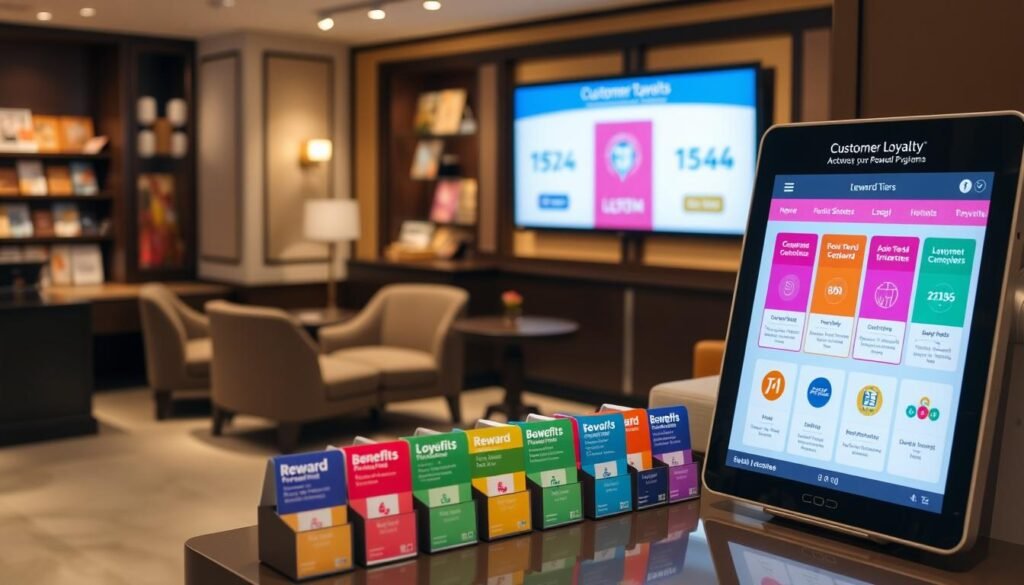Address
304 North Cardinal
St. Dorchester Center, MA 02124
Work Hours
Monday to Friday: 7AM - 7PM
Weekend: 10AM - 5PM
Address
304 North Cardinal
St. Dorchester Center, MA 02124
Work Hours
Monday to Friday: 7AM - 7PM
Weekend: 10AM - 5PM

Are you finding it hard to keep customers coming back? In today’s market, it’s not just about selling. It’s about building a lasting relationship with your customers.
To achieve this, you need to understand the importance of customer loyalty. You must use effective strategies to create long-term brand advocates. This way, you can keep more customers and help your business grow.
In today’s competitive market, customer loyalty is key for business growth. Loyal customers often come back, buy more, and tell others about your brand.
Customer loyalty is more than keeping customers. It’s about building a loyal group that supports your brand. This loyalty can boost customer retention, cut marketing costs, and increase profits.
Loyalty is vital for a company’s success. Loyal customers tend to spend more and try new things. This boosts their average order value and lifetime value.
Loyal customers are also less likely to switch to competitors. This makes them a reliable source of income. By focusing on customer retention, businesses can save on getting new customers.
Loyal customers bring many benefits. They help keep revenue steady and act as brand ambassadors. They promote your business through personal recommendations.
| Benefits | Description | Impact |
|---|---|---|
| Increased Revenue | Loyal customers make repeat purchases | Higher sales and profitability |
| Positive Word-of-Mouth | Customers recommend your brand | Enhanced brand reputation and new customer acquisition |
| Valuable Feedback | Loyal customers provide insightful feedback | Improved products and services |
By valuing customer loyalty and working to keep it, businesses can achieve long-term success.
To build a loyal customer base, creating a strong brand identity is key. A well-defined brand identity makes you stand out and connects with your audience emotionally.
A compelling brand story is at the heart of a strong brand identity. Your story should share your mission, values, and what makes you unique. It’s about showing your business’s ‘why’, making it relatable and human.
Warby Parker’s story is about affordable, fashionable eyewear with a social conscience. This has helped them win loyal customers.
Consistency is crucial for a strong brand identity. Every touchpoint, from your website to customer service, should show your brand’s story and values.
| Channel | Consistency Elements |
|---|---|
| Website | Brand colors, logo, tone of voice |
| Social Media | Visual style, language, engagement |
| Packaging | Design, brand messaging |
Keeping consistency across all channels strengthens your brand identity. This makes your brand more recognizable and trustworthy to your customers.

Exceptional customer service is essential for businesses wanting to increase customer retention. It involves training employees well and creating a culture that puts customers first.
Your employees are the face of your brand. They must be trained to handle customer questions and problems well. Here are some tips:
A culture that focuses on customers is key. To build this, consider these steps:
By working on these points, you can boost your customer service. This leads to better customer loyalty and success in your customer loyalty programs.
Using customer data to create personalized experiences is a powerful way to turn shoppers into loyal customers. By understanding your customers’ preferences and behaviors, you can tailor your marketing efforts to meet their individual needs.
Effective use of customer data allows you to create targeted marketing campaigns that resonate with your audience. This involves analyzing customer behavior, purchase history, and other relevant data to identify patterns and preferences.
Benefits of Targeted Marketing:
| Marketing Strategy | Customer Data Used | Outcome |
|---|---|---|
| Email Campaigns | Purchase History, Browsing Behavior | Increased Open Rates |
| Personalized Offers | Customer Preferences, Loyalty Program Data | Boosted Sales |
Tailoring recommendations and offers to individual customers can significantly enhance their shopping experience. This can be achieved by using data analytics to understand customer preferences and behaviors.
For instance, an online retailer can use browsing history and purchase data to recommend products that are likely to interest a customer.
By implementing these personalization techniques, you can create a more engaging and relevant experience for your customers. This drives loyalty and retention.
A good reward program is key to keeping customers coming back. It rewards them for buying again and again. This helps businesses keep more customers.
To make a great loyalty program, know what your customers like. Make sure your rewards match their interests. The program should be simple to join and understand.
Think about these things when you’re setting up your loyalty program:
Loyalty programs can boost customer retention by up to 25%. A retail expert says, « It’s not just about giving rewards. It’s about connecting with customers on an emotional level. »
« The key to a successful loyalty program is to make it personal and relevant to your customers’ needs. »
After you’ve set up your loyalty program, it’s important to promote it well. Use email, social media, and in-store promotions to get people excited about your program.
| Promotion Channel | Benefits |
|---|---|
| Email Marketing | Targeted campaigns, cost-effective |
| Social Media | Wide reach, engaging content |
| In-Store Promotions | Personal interaction, immediate impact |
Good promotion can get more people involved in your loyalty program. This boosts customer engagement and participation.

Building a loyal customer base is more than just selling products. It’s about creating a community around your brand. This approach boosts customer loyalty and encourages repeat business.
Building a community starts with social media. Create engaging social media groups for customers to connect with each other and your brand. Share content, reply to comments, and keep up with industry trends.
Local events and workshops also build community. They let customers meet, share, and learn from each other.
Plan events that add value to your customers. This could be a product demo, a workshop, or a meet-and-greet. Promote your events effectively on social media and email to draw a crowd.
By using these strategies, you can build a strong community around your brand. This leads to more customer loyalty and business growth.
Getting and using customer feedback can really boost loyalty. It means collecting feedback often and improving your offerings.
Surveys are a great way to get feedback. You can use emails, social media, or in-store forms. Keep your surveys short and to the point to get more answers.
Ask customers how happy they are with your service or product. Also, ask open questions for more detailed feedback.

After getting feedback, it’s key to act on it. Look for common themes or areas to improve. Focus on changes that will make customers happier.
Here are some ways to improve based on feedback:
| Feedback Category | Action Taken | Result |
|---|---|---|
| Product Quality | Improved manufacturing process | Increased customer satisfaction ratings |
| Customer Service | Enhanced employee training | Reduced customer complaints |
| Delivery Times | Optimized logistics | Faster delivery times |
By surveying customers often and making changes, you show you care. This builds a loyal customer base.
Building customer loyalty needs regular and personal communication. Email marketing is key here. It helps keep customers interested and up-to-date with your offerings.
Segmenting your email lists is essential for sending the right content to your customers. You should group them by their interests, past purchases, and other important details. For example, you can split your list into those who bought recently, those who left items in their cart, or those interested in certain products.
Good segmentation means you can send messages that really speak to your audience. This boosts the chance of them taking action. Here are some ways to segment:
| Segmentation Criteria | Description | Example |
|---|---|---|
| Demographic Information | Age, gender, location | Targeting promotions to specific age groups |
| Purchase History | Previous purchases, frequency | Offering loyalty rewards to frequent buyers |
| Email Engagement | Open rates, click-through rates | Sending re-engagement campaigns to inactive subscribers |
Creating content that grabs attention and drives action is crucial. Your emails should be informative, look good, and match what your audience likes.
To do this, try these tips:

By using these strategies, you can make your email marketing better. This leads to more engaged and loyal customers. Keep your tone and style consistent and always be ready to adjust based on feedback and results.
Creating an omnichannel shopping experience is key to keeping customers and building loyalty. Today, shoppers want a smooth experience online and offline. They expect it all to work together seamlessly.
To make this happen, you must let customers easily switch between different places like social media, websites, and stores. You need a plan that ties everything together. This plan should share the same brand message and experience everywhere.
To make the transition smooth, use a unified commerce platform. This platform connects all your channels and touchpoints. It lets you manage customer interactions and data in real-time, offering a consistent and personal experience.
Some important steps for a smooth transition include:
Technology is crucial for improving the omnichannel shopping experience. By using tools like artificial intelligence, augmented reality, and mobile apps, you can make shopping more fun and interactive. This helps build customer loyalty.
For instance, mobile apps can offer personalized deals and suggestions. Augmented reality lets customers see products in their own space.
By combining a smooth transition with the right technology, you can create an omnichannel experience. This experience keeps customers coming back and builds loyalty.
To turn shoppers into loyal customers, measuring and analyzing loyalty is key. This helps you spot areas to improve and boost customer retention.
Tracking important metrics like customer retention rate and net promoter score is essential. These metrics show how well your loyalty strategies work. They give insights into what customers like and don’t like.
Improvement is crucial to stay ahead. Listen to customer feedback and tweak your strategies. Regularly checking and improving your approach boosts loyalty and business growth. This helps turn shoppers into loyal customers and keeps them coming back.
Customer loyalty means customers keep coming back to a company or brand. It’s key for businesses because loyal customers buy more, tell friends, and speak well of the brand. This helps the business grow and keeps customers coming back.
To get loyal customers, focus on making them happy. Offer great service, personalise their experience, have a reward program, and create a community feeling.
Loyalty programs reward customers for coming back. This makes them more likely to stay, be happier, and help your business grow.
Track loyalty by looking at retention, repeat buys, and Net Promoter Score (NPS). These metrics show if your loyalty efforts are working and where you can get better.
Omnichannel shopping means a smooth experience online, offline, and on mobile. It boosts satisfaction and loyalty by making shopping easy and enjoyable.
Use email to keep in touch with customers. Segment your list, send relevant content, and personalise messages. This builds a loyal customer base.
Feedback is vital for loyalty. It shows what customers want and need. Use it to improve and keep customers happy and loyal.